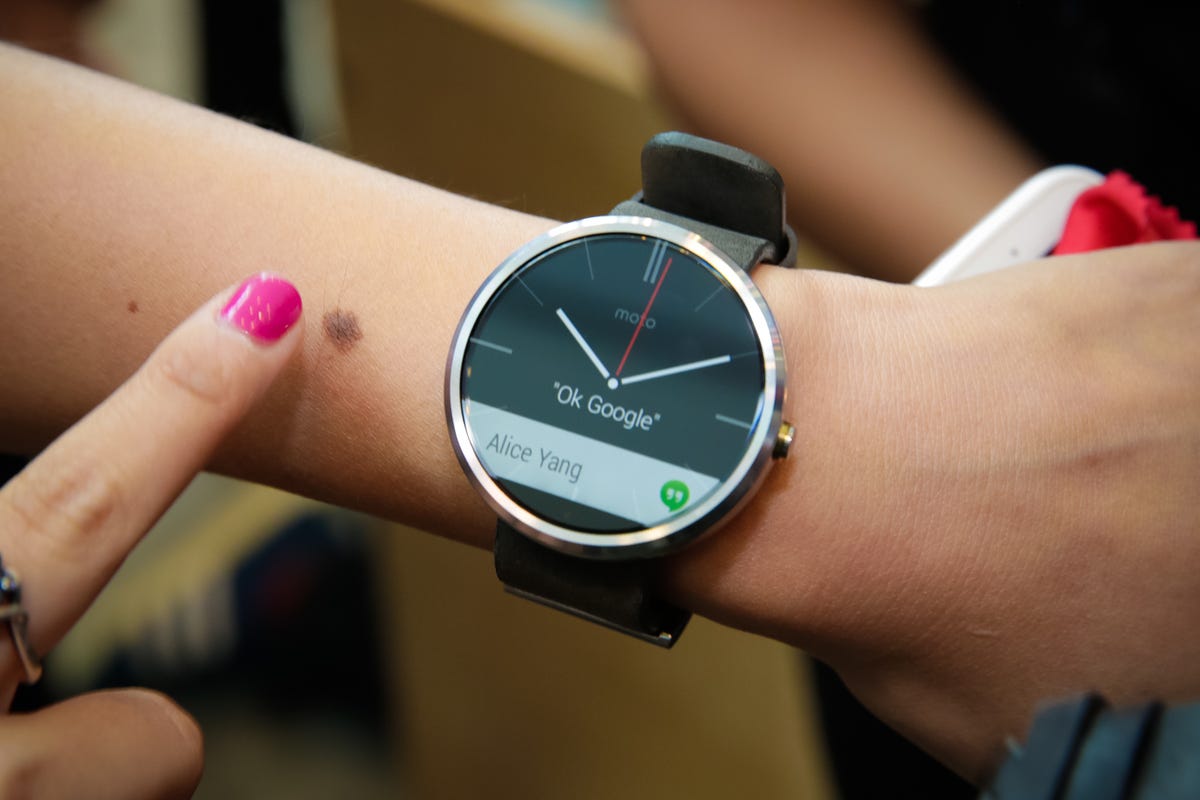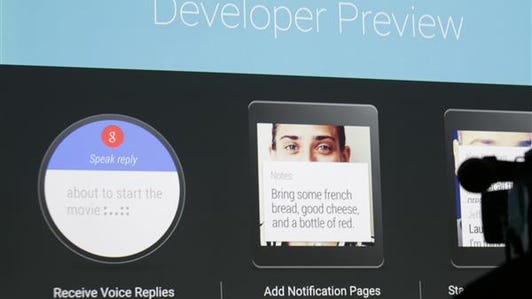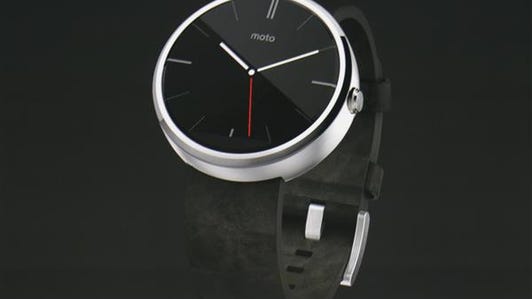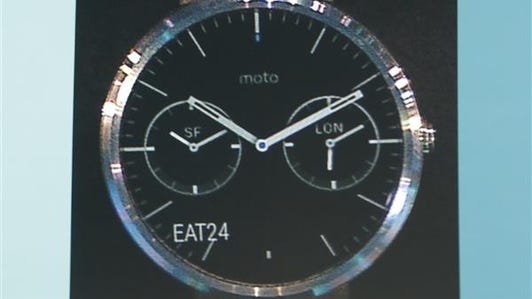Google is the latest technology giant to make some noise about smartwatches and the broader realm of “wearable” technology. But is now the right time for consumers to jump on the bandwagon?

During the Google’s opening keynote for its Google I/O developer conference in San Francisco this week, the company took the wraps off Android Wear, software that will power smartwatches and new Internet-connected devices beyond smartphones and tablets.
This software puts Google at the epicenter of what many analysts see as the next big thing in everyday technology. But so far, smartwatches and other wearables have had a slow start in terms of consumer demand.
In this edition of Ask Maggie I offer my opinions on where I see the wearables market going and whether I think it’s worthwhile technology today.
Do you need a smartwatch?
Dear Maggie,
I’ve been thinking about getting a smartwatch, but is it really worth it? They seem kind of pricey and I’m not sure if they do something that my smartphone doesn’t already do. Also do you think this summer is a good time to buy one? Or should I wait?
Thanks,
Jared
Dear Jared,
This is a great question. The short answer, in my opinion, is, “No, I don’t find these devices necessary.” Smartwatches and other “fitness” wearables that are being hyped right now seem like a waste of money to me. But I’m a bit of cheapskate.
If you’re dead set on buying one, I’d wait until later this year when Apple is expected to announce a new wearable device, and then see how things are shaping up. You may also want to check out the three smartwatches that Google announced at the I/O conference. The LG G Watch and Samsung Gear Live will go on sale in stores July 7. And the Moto 360 smartwatch will be available later this summer.


James Martin/CNET
Even though I don’t see a need for anyone to buy a smartwatch at this point, technology companies and device makers like Google and Samsung are likely to give you a very different answer. They will tell you that smartwatches and other wearables will be the next hot thing. For these companies, wearables represent a new category of product that will help them boost revenue as sales of their existing smartphones and tablets begins to slow.
But does anyone really need a smartwatch? I suppose the same question could have been asked about cell phones when they were the new technology on the block. I’m sure back then the answer was no. If someone wanted to reach you or you wanted to make a phone call, it could wait until you got to your home or office.
At some point over the years, though, cell phones went from being a luxury to something that’s so important to people’s safety and well-being that many parents give them to their grade school children.
Smartphones, which allow users to browse the Internet, navigate via GPS and access millions of apps, are also well on their way to being viewed as necessities rather than luxuries. For many people around the world, a smartphone provides their only access to the Internet.
“It’s still early days for these products,” said Jefferson Wang, senior partner in charge of wireless at IBB Consulting. “The products available today are really setting the stage for what these devices will be able to do in the future.”
Google I/O 2014: Android wearables coming to your wrist (pictures)






+12 more
That said, when it comes to the current crop of smartwatches and fitness bands, I don’t see the point of owning these devices, especially when many of them cost $200 or more.
The biggest problem I have with smartwatches is that most of them need to be paired with a smartphone or tablet to do anything other than tell the time. In fact, it seems like today’s smartwatches are little more than souped-up Bluetooth gadgets used to control a smartphone or tablet.
For example, the new Android Wear software that will power many upcoming wearable devices can be used to activate a do-not-disturb setting for your phone. It also lets you issue voice commands to control connected Android smartphones. This might include checking voice mail messages or activating a music app on an Android phone. These devices will also be able to store things, such as boarding passes for flights. Smartwatches already on the market allow users to answer phone calls or read text messages.
Related stories
- Samsung: We’ll differentiate our Android Wear smartwatch over time
- How Android Wear changes wearables
- Samsung Gear Live vs. LG G Watch vs. Moto 360 specs: Comparing the watches of Android Wear
- Google spells out ambitious plan: Android world domination
Some of this functionality sounds interesting, but the truth is that there are Bluetooth gadgets and headsets that do the same thing as these smartwatches for a fraction of the price. For instance the new LG G Watch and Samsung Gear Live that are being shown off at Google I/O this week cost $229 and $199 respectively. That’s a pretty hefty price tag considering that you can get a smartphone for around $200 or $100 with a two-year service contract.
Then there are the devices that are mainly focused on fitness and health. Many consumers in the market for a smartwatch are likely looking for fitness features like tracking how many steps you take in a day, mapping a run or bike ride, or sensing your heart rate.
Of course, some of this information can also be tracked easily with a smartphone. And there are dozens of apps that can do that. So why do you need a $200-plus device you wear on your wrist to do this?
One reason is that device manufacturers may be able to pack more sensors onto a wristband or watch in order to gather all this data. So in that respect, the smartwatch may actually offer a function that can’t be replicated as easily on a smartphone.
The bigger question I have is what people will really do with all this data once it’s collected. Google and Apple have developed platforms that they say will help users keep track of their fitness goals across a wide range of devices. Earlier this week, mobile operator Sprint also said it has a new platform for keeping track of fitness devices and apps.
But for the vast majority of Americans, all this data will be collected and never looked at again. Even fitness buffs like my husband have fallen into this trap. As an avid runner and cyclist, he had a GPS watch that he used to map his routes. The watch would record his activity and then when he came home, he’d sync the device to the home computer after each time he went for a ride.
Soon he realized he never went back to look at any of the data that had been collected about each of his rides. It felt like a waste of time.
This is not to say that fitness and health apps on mobile devices don’t have a place in the market. They can be used to motivate you to get more active. But the real question is how valuable consumers will find this information, and whether they will actually stick with their workout regimens.
The Bottom Line:
This market is just getting off the ground. And unless you are dying to part of the early test market for the various smartwatch and wearable tech makers, I’d wait awhile before pulling the trigger on a new device. At the very least, you should wait until the fall when Apple will announce its hotly anticipated wearable device.
I hope this advice was helpful. Good luck!
Ask Maggie is an advice column that answers readers’ wireless and broadband questions. If you have a question, I’d love to hear from you. Please send me an e-mail at maggie dot reardon at cbs dot com. And please put “Ask Maggie” in the subject header. You can also follow me on Facebook on my Ask Maggie page.



